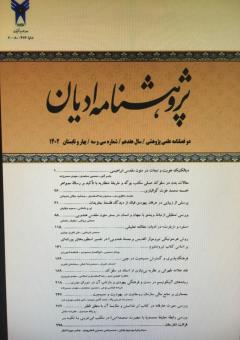جادوی قدسی در آیین مزدیسنا: تحلیلی از رابطه مناسک، عرفان و منثره
محورهای موضوعی : ادیان ایران باستان
زهرا ملکی
1
![]() ,
محمود رضا اسفندیار
2
*
,
محمود رضا اسفندیار
2
*
![]() ,
فاطمه سلیمانی کوشالی
3
,
فاطمه سلیمانی کوشالی
3
![]()
1 - داشجوی دکتری گروه ادیان و عرفان، واحد یادگار امام خمینی شهرری، دانشگاه آزاد اسلامی، تهران، ایران
2 - دانشیار گروه ادیان و عرفان، واحد تهران مرکزی، تهران، ایران(نویسنده مسوول)
3 - استادیار گروه معارف اسلامی، دانشگاه آزاد اسلامی واحد اسلامشهر، تهران، ایران
کلید واژه: جادوی قدسی, مزدیسنا, منثره, مناسک دینی, تجربه عرفانی, اشه.,
چکیده مقاله :
در این مقاله، به تحلیل نقش جادوی قدسی در آیین مزدیسنا پرداخته میشود و رابطه آن با مناسک دینی و تجربه عرفانی مورد بررسی قرار میگیرد. با وجود مذمتِ متون اوستایی و پهلوی نسبت به جادو به عنوان ابزار فتنه و تخریب اهریمنی، تحلیل دقیق این متون نشان میدهد که نوعی جادوی مثبت و مقدس -که در اینجا «جادوی قدسی» نامیده میشود- در بطن آیین مزدیسنا جای دارد. این جادو، متکی بر منثرهها (کلام مقدس)، مناسک دینی و سلوک معنوی است و به عنوان ابزاری برای مقابله با نیروهای شر، حفظ نظم الهی (اشه) و تحقق تجربه عرفانی عمل میکند. یافتهها نشان میدهند که در نظام دوگانهانگار مزدیسنا، در مقابل هر قدرت اهریمنی، معادلی مینوی وجود دارد؛ از این رو، جادوی قدسی نه تنها مقبول، بلکه یکی از ابعاد ضروری تجربه دینی و عرفانی است. این مفهوم، از طریق تلفیق مناسک، تجربه عرفانی و قدرت کلام مقدس (منثره)، به تحقق نظم الهی و مقابله با فساد کیهانی منجر میشود. این مقاله با روش توصیفی-تحلیلی و با استناد به متون اوستا و پهلوی (از جمله بندهش، دینکرد، زادسپرم و ارداویرافنامه)، به بازشناسی جادوی قدسی به عنوان یکی از ابعاد اصیل آیین مزدیسنا میپردازد.
This article analyzes the role of sacred magic in Zoroastrianism, exploring its relationship with religious rituals and mystical experiences. Although Avestan and Pahlavi texts condemn magic as a tool of malevolent deception and Ahrimanian destruction, a thorough analysis reveals a positive and sacred form of magic—termed "sacred magic"—integral to Zoroastrianism. Rooted in manthras (sacred words), religious rituals, and spiritual practice, sacred magic serves to counter evil forces, uphold divine order (asha), and facilitate mystical experiences. The findings show that within Zoroastrianism’s dualistic framework, every Ahrimanian force has a corresponding spiritual (minoo) counterpart, rendering sacred magic not only acceptable but a vital dimension of religious and mystical experience. By integrating rituals, mystical experiences, and the power of manthras, sacred magic contributes to realizing divine order and opposing cosmic corruption. Using a descriptive-analytical approach and drawing on Avestan and Pahlavi texts, including Bundahishn, Dinkard, Zadspram, and Arda Viraf Nameh, this study re-evaluates sacred magic as an authentic dimension of Zoroastrianism.
بهار، مهرداد. (1386). ادیان آسیایی. تهران: چشمه
بویس، مری. (1377). چکیده تاریخ کیش زرتشت. ترجمه همایون صنعتی زاده. تهران: صفیعلیشاه
پورداود، ابراهیم. (1310). خرده اوستا. تهران: نشر اساطیر
رضی، هاشم. (1343). تاریخ ادیان؛ کتاب اول: نظامات مذهبی در جهان. تهران: کاوه
راشد محصل، محمدتقی. (1389). دینکرد. تهران: پژوهشگاه علوم انسانی و مطالعات فرهنگی
راشد محصل، محمدتقی. (1390). زادسپرم. تهران: پژوهشگاه علوم انسانی و مطالعات فرهنگی
فریزر، جیمز ج. (1392). شاخه زرین. ترجمه کاظم فیروزمند. تهران: آگاه
کربن، هانری. (1393). چشماندازهای معنوی و فلسفی اسلام ایرانی. ترجمه ماشاءالله رحمتی. تهران: صوفیا
مالینوفسکی، برانیسلاو. (1398). جادو، علم و دین. ترجمه بهنام خلیلیان. تهران: جامی
مزداپور، کتایون. (1369). شایست ناشایست. تهران: پژوهشگاه علوم انسانی و مطالعات فرهنگی
نصر، سیدحسین. (1384). دین و نظام طبیعت. ترجمه محمدحسین غفوری. تهران: حکمت
همیلتون، ملکم. (1377). جامعهشناسی دین. ترجمه محسن ثلاثی. تهران: موسسه فرهنگی انتشاراتی تبیان
هینلز، جان راسل. (1381). شناخت اساطیر ایران. ترجمه ژاله آموزگار و احمد تفضلی. تهران: چشمه
دوستخواه، جلیل. (1392). اوستا؛ کهنترین سرودهای ایرانیان. تهران: مروارید
In this article, an analysis of the role of sacred magic in Zoroastrianism is presented, exploring its relationship with religious rituals and mystical experiences. Despite the condemnation of magic in Avestan and Pahlavi texts as a tool of malevolent deception and Ahrimanian destruction, with a deeper analysis, a meticulous examination of these texts reveals the presence of a positive and sacred form of magic—here termed "sacred magic"—embedded within the core of Zoroastrianism. This sacred magic relies on manthras (sacred words), religious rituals, and spiritual conduct, serving as a means to counter evil forces, uphold divine order (asha), and facilitate mystical experiences. The findings indicate that within the dualistic framework of Zoroastrianism, for every Ahrimanian force, there exists a corresponding spiritual (minoo) counterpart. Consequently, sacred magic is not only accepted but constitutes an essential dimension of religious and mystical experience. Through the integration of rituals, mystical experiences, and the power of sacred words (manthras), this concept contributes to the realization of divine order and the opposition to cosmic corruption. Employing a descriptive-analytical method and drawing on Avestan and Pahlavi texts, this article seeks to re-examine sacred magic as an authentic dimension of Zoroastrianism. Boyer, Pascal. (2001). Religion Explained: The Evolutionary Origins of Religious Thought. Basic Books
Choksy, Jamsheed K. (2005). Zoroastrianism. In L. Jones (Ed.), Encyclopedia of Religion (2nd ed., Vol. 14, pp. 9987–10005). Macmillan
De Jong, Louis. (2005), Writing the History of Occupied Europe, Contemporary European History 14(03), doi:10.1017/S0960777305002535
Dostkhah, Jalil. (2013). Avesta: The oldest Iranian hymns (17th ed.). Morvarid
Gignoux, P., & Amuzegar, J. (Trans.). (1993). Ardaviraf Nameh [The book of Ardaviraf]. Tehran: Moein Publications & French Institute of Iranology
Herodotus (1890). The Histories. trans. by G. C. Macaulay. London: Macmillan
Kargar, M. (2009). Ardaviraf Nameh: A Critical Study. Tehran: Institute for Humanities and Cultural Studies

